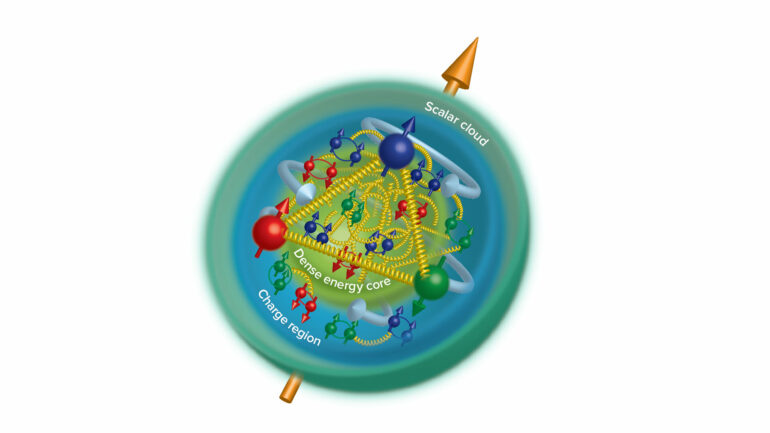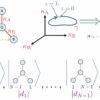Nuclear physicists may have finally pinpointed where in the proton a large fraction of its mass resides. A recent experiment carried out at the U.S. Department of Energy’s Thomas Jefferson National Accelerator Facility has revealed the radius of the proton’s mass that is generated by the strong force as it glues together the proton’s building block quarks. The result was recently published in Nature.
One of the biggest mysteries of the proton is the origin of its mass. It turns out that the proton’s measured mass doesn’t just come from its physical building blocks, its three so-called valence quarks.
“If you add up the Standard Model masses of the quarks in a proton, you only get a small fraction of the proton’s mass,” explained experiment co-spokesperson Sylvester Joosten, an experimental physicist at DOE’s Argonne National Laboratory.
Over the last few decades, nuclear physicists have tentatively pieced together that the proton’s mass comes from several sources. First, it gets some mass from the masses of its quarks, and some more from their movements. Next, it gets mass from the strong force energy that glues those quarks together, with this force manifesting as “gluons.” Lastly, it gets mass from the dynamic interactions of the proton’s quarks and gluons.
This new measurement may have finally shed some light on the mass that is generated by the proton’s gluons by pinpointing the location of the matter generated by these gluons. The radius of this core of matter was found to reside at the center of the proton. The result also seems to indicate that this core has a different size than the proton’s well-measured charge radius, a quantity that is often used as a proxy for the proton’s size.
“The radius of this mass structure is smaller than the charge radius, and so it kind of gives us a sense of the hierarchy of the mass versus the charge structure of the nucleon,” said experiment co-spokesperson Mark Jones, Jefferson Lab’s Halls A&C leader.
According to experiment co-spokesperson Zein-Eddine Meziani, a staff scientist at DOE’s Argonne National Laboratory, this result actually came as somewhat of a surprise.
“What we have found is something that we really weren’t expecting to come out this way. The original goal of this experiment was a search for a pentaquark that has been reported by researchers at CERN,” Meziani said
The experiment was performed in Experimental Hall C in Jefferson Lab’s Continuous Electron Beam Accelerator Facility, a DOE Office of Science user facility. In the experiment, energetic 10.6 GeV (billion electron-volt) electrons from the CEBAF accelerator were sent into a small block of copper. The electrons were slowed down or deflected by the block, causing them to emit bremsstrahlung radiation as photons. This beam of photons then struck the protons inside a liquid hydrogen target. Detectors measured the remnants of these interactions as electrons and positrons.
The experimenters were interested in those interactions that produced J/Ψ particles amongst the hydrogen’s proton nuclei. The J/Ψ is a short-lived meson that is made of charm/anti-charm quarks. Once formed, it quickly decays into an electron/positron pair.
Of the billions of interactions, the experimenters found about 2,000 J/Ψ particles in their cross section measurements of these interactions by confirming the coincident electron/positron pairs.
“It’s similar to what we’ve been doing all along. By doing elastic scattering of the electron on the proton, we’ve been getting the proton’s charge distribution,” said Jones. “In this case, we did exclusive photo-production of the J/Ψ from the proton, and we’re getting the gluon distribution instead of the charge distribution.”
The collaborators were then able to insert these cross section measurements into theoretical models that describe the gluonic gravitational form factors of the proton. The gluonic form factors detail the mechanical characteristics of the proton, such as its mass and pressure.
“There were two quantities, known as gravitational form factors, that we were able to pull out, because we had access to these two models: the generalized parton distributions model and the holographic quantum chromodynamics (QCD) model. And we compared the results from each of these models with lattice QCD calculations,” Meziani added.
From two different combinations of these quantities, the experimenters determined the aforementioned gluonic mass radius dominated by graviton-like gluons, as well as a larger radius of attractive scalar gluons that extend beyond the moving quarks and confine them.
“One of the more puzzling findings from our experiment is that in one of the theoretical model approaches, our data hint at a scalar gluon distribution that extends well beyond the electromagnetic proton radius,” Joosten said. “To fully understand these new observations and their implications on our understanding of confinement, we will need a new generation of high-precision J/Ψ experiments.”
One possibility for further exploration of this tantalizing new result is the Solenoidal Large Intensity Device experiment program, called SoLID. The SoLID program is still in the proposal stage. If approved to move forward, experiments conducted with the SoLID apparatus would provide new insight into J/Ψ physics.
“The big next step is to measure J/Ψ production with the SoLID detector. It will really be able to make high-precision measurements in this region. One of the major pillars of that program is J/Ψ production, along with transverse momentum distribution measurements and parity-violating deep inelastic scattering measurements,” Jones said.
Jones, Joosten and Meziani represent an experimental collaboration that includes more than 50 nuclear physicists from 10 institutions. The spokespeople also want to highlight Burcu Duran, the lead author and a postdoctoral research associate at the University of Tennessee, Knoxville. Duran featured this experiment in her Ph.D. thesis as a graduate student at Temple University, and she was a driving force behind the analysis of the data.
The collaboration conducted the experiment over about 30 days in February–March 2019. They agree that this new result is intriguing, and they say that they all are looking forward to future results that will shed additional light on the glimpses of new physics that it implies.
“The bottom line for me—there’s an excitement right now. Could we find a way to confirm what we are seeing? Is this new picture information going to stick?” Meziani said. “But to me, this is really very exciting. Because if I think now of a proton, we have more information about it now than we’ve ever had before.”
More information:
Zein-Eddine Meziani, Determining the gluonic gravitational form factors of the proton, Nature (2023). DOI: 10.1038/s41586-023-05730-4. www.nature.com/articles/s41586-023-05730-4
Provided by
Thomas Jefferson National Accelerator Facility
Citation:
Experiment finds gluon mass in the proton (2023, March 29)



